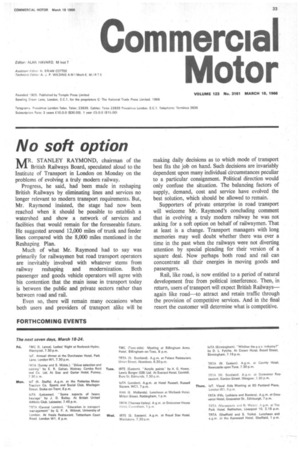No soft option
Page 35

If you've noticed an error in this article please click here to report it so we can fix it.
MR. STANLEY RAYMOND, chairman of the British Railways Board, speculated aloud to the Institute of Transport in London on Monday on the problems of evolving a truly modern railway.
Progress, he said, had been made in reshaping British Railways by eliminating lines and services no longer relevant to modern transport requirements. But, Mr. Raymond insisted, the stage had now been reached when it should be possible to establish a watershed and show a network of services and facilities that would remain for the foreseeable future. He suggested around 12,000 miles of trunk and feeder lines compared with the 8,000 miles mentioned in the Reshaping Plan.
Much of what Mr. Raymond had to say was primarily for railwaymen but road transport operators are inevitably involved with whatever stems from railway reshaping and modernization. Both passenger and goods vehicle operators will agree with his contention that the main issue in transport today is between the public and private sectors rather than between road and rail.
Even so, there will remain many occasions when both users and providers of transport alike will be making daily decisions as to which mode of transport best fits the job on hand. Such decisions are invariably dependent upon many individual circumstances peculiar to a particular consignment. Political direction would only confuse the situation. The balancing factors of supply, demand, cost and service have evolved the best solution, which should be allowed to remain.
Supporters of private enterprise in road transport will welcome Mr. Raymond's concluding comment that in evolving a truly modern railway he was not asking for a soft option on behalf of railwaymen. That at least is a change. Transport managers with long memories may well doubt whether there was ever a time in the past when the railways were not diverting attention by special pleading for their version of a square deal. Now perhaps both road and rail can concentrate all their energies in moving goods and passengers.
Rail, like road, is now entitled to a period of natural development free from political interference. Then, in return, users of transport will expect British Railways— again like road—to attract and retain traffic through the provision of competitive services. And in the final resort the customer will determine what is competitive.




































































































































































